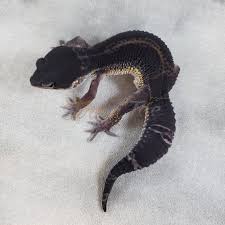GECKO MELANISTIC DARK (Eublepharis macularius )
$250.00
Full Description
Here is a detailed care guide for Melanistic Dark Leopard Geckos (Eublepharis macularius), a term generally used for geckos with increased melanin, resulting in a darker overall appearance. These geckos are often confused with or derived from Black Night, Black Pearl, or other dark-morph lines, but “melanistic dark” may also apply to selectively bred individuals with no formal morph name.
Melanistic Dark Leopard Gecko Care Guide
Morph Overview
| Trait | Description |
|---|---|
| Common Name | Melanistic Dark Leopard Gecko |
| Scientific Name | Eublepharis macularius |
| Morph Type | Line-bred / Polygenic |
| Appearance | Overall charcoal, slate, or near-black coloration; some may retain faint spotting or banding |
| Experience Level | Intermediate |
Size & Lifespan
| Feature | Range |
|---|---|
| Adult Length | 7–10 inches (18–25 cm) |
| Adult Weight | 50–80 grams |
| Lifespan | 15–20+ years in captivity |
Enclosure Setup
Minimum Enclosure Sizes
| Gecko Stage | Tank Size |
|---|---|
| Juvenile | 10–20 gallons |
| Adult | 20–40 gallons (horizontal) |
Substrate Options
| ✅ Safe | ❌ Avoid |
|---|---|
| Paper towels | Loose sand |
| Ceramic/slate tile | Calcium sand |
| Reptile carpet | Bark, wood chips, soil (unless bioactive) |
| Bioactive (for experienced keepers) | Gravel |
️ Temperature & Humidity
| Area | Temp (°F) | Temp (°C) |
|---|---|---|
| Warm Side | 88–92°F | 31–33°C |
| Cool Side | 75–80°F | 24–27°C |
| Night Temp | 68–72°F | 20–22°C |
| Humidity | 30–40% ambient, 70–80% in humid hide |
Heating Tips
-
Use a UTH (Under-Tank Heater) on a digital thermostat
-
Check surface temperature with a probe thermometer
-
Optional: Low-output basking bulb for extra ambient warmth
Lighting
-
UVB is optional but beneficial (5–6% linear UVB like Arcadia ShadeDweller)
-
Provide shaded areas — dark morphs may be more light-sensitive
-
Maintain a 12-hour day/night cycle
Tip: Dim ambient light or red-spectrum lighting helps preserve their dark color and reduces stress.
️ Hides & Decor
Provide at least three hides:
-
Warm Hide – above heat source
-
Cool Hide – on the cooler side of the tank
-
Humid Hide – for shedding (filled with moist moss or coco fiber)
Optional:
-
Climbing branches, fake plants, textured rocks
-
Flat basking tiles
Feeding & Supplements
Staple Insects:
-
Dubia roaches
-
Crickets
-
Mealworms
-
Black Soldier Fly Larvae (BSFL)
Treats (Use sparingly):
-
Superworms
-
Waxworms (very fatty)
Feeding Frequency:
| Age | Schedule |
|---|---|
| Juveniles | Daily |
| Adults | Every 2–3 days |
Supplement Schedule
| Supplement | Frequency |
|---|---|
| Calcium (no D3) | Always available |
| Calcium + D3 | 1–2× weekly |
| Multivitamin | 1× weekly |
Always gut-load feeder insects 24 hours before feeding.
Cleaning & Maintenance
| Task | Frequency |
|---|---|
| Spot clean | Daily |
| Water refresh | Daily |
| Replace substrate | Monthly (non-bioactive) |
| Deep clean | Monthly |
⚠️ Morph-Specific Considerations
| Issue | Note |
|---|---|
| Color fading | Dark morphs may lighten under bright lights or stress |
| Light sensitivity | Some may avoid bright spaces; offer shaded hides |
| Inbreeding risks | If derived from Black Night line, monitor for lethargy, weak immune systems, or poor appetite |
| Thermoregulation | Darker geckos absorb heat more efficiently; monitor temps closely |
Handling Tips
-
Wait 1–2 weeks after bringing home before handling
-
Handle during evening when geckos are most active
-
Always support the body, move slowly, and don’t grab the tail
-
Limit handling to 5–10 minutes initially
✅ Quick Care Summary
| Feature | Best Practice |
|---|---|
| Enclosure Size | 20–40 gal horizontal tank |
| Substrate | Tile, paper towel, or bioactive |
| Heating | UTH with thermostat (88–92°F hotspot) |
| Lighting | UVB optional; avoid intense lights |
| Humidity | 30–40%, with humid hide |
| Feeding | Insects, dusted, gut-loaded |
| Supplements | Calcium daily, D3 and vitamins weekly |
| Handling | Calm, limited, dusk/evening preferred |

